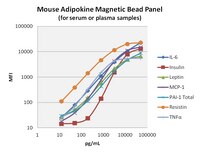Polychlorinated biphenyl 153 is a diet-dependent obesogen that worsens nonalcoholic fatty liver disease in male C57BL6/J mice.
Wahlang, B; Falkner, KC; Gregory, B; Ansert, D; Young, D; Conklin, DJ; Bhatnagar, A; McClain, CJ; Cave, M
The Journal of nutritional biochemistry
24
1587-95
2013
Kivonat megmutatása
Polychlorinated biphenyls (PCBs) are persistent environmental pollutants that are detectable in the serum of all American adults. Amongst PCB congeners, PCB 153 has the highest serum level. PCBs have been dose-dependently associated with obesity, metabolic syndrome and nonalcoholic fatty liver disease (NAFLD) in epidemiological studies.The purpose of this study is to determine mechanisms by which PCB 153 worsens diet-induced obesity and NAFLD in male mice fed a high-fat diet (HFD).Male C57BL6/J mice were fed either control or 42% milk fat diet for 12 weeks with or without PCB 153 coexposure (50 mg/kg ip ×4). Glucose tolerance test was performed, and plasma and tissues were obtained at necropsy for measurements of adipocytokine levels, histology and gene expression.In control diet-fed mice, addition of PCB 153 had minimal effects on any of the measured parameters. However, PCB 153 treatment in high-fat-fed mice was associated with increased visceral adiposity, hepatic steatosis and plasma adipokines including adiponectin, leptin, resistin and plasminogen activator inhibitor-1 levels. Likewise, coexposure reduced expression of hepatic genes implicated in β-oxidation while increasing the expression of genes associated with lipid biosynthesis. Regardless of diet, PCB 153 had no effect on insulin resistance or tumor necrosis factor alpha levels.PCB 153 is an obesogen that exacerbates hepatic steatosis, alters adipocytokines and disrupts normal hepatic lipid metabolism when administered with HFD but not control diet. Because all US adults have been exposed to PCB 153, this particular nutrient-toxicant interaction potentially impacts human obesity/NAFLD. | 23618531
 |
Effects of dietary strawberry powder on blood lipids and inflammatory markers in obese human subjects.
Zunino, SJ; Parelman, MA; Freytag, TL; Stephensen, CB; Kelley, DS; Mackey, BE; Woodhouse, LR; Bonnel, EL
The British journal of nutrition
108
900-9
2011
Kivonat megmutatása
Obesity is a strong risk factor for the development of CVD, hypertension and type 2 diabetes. The overall goal of the present pilot study was to feed strawberries, in the form of freeze-dried powder, to obese subjects to determine whether dietary strawberries beneficially altered lipid profiles and reduced blood markers of inflammation compared with a control intervention. A total of twenty healthy subjects (thirteen females and seven males) aged between 20 and 50 years with a BMI between 30 and 40 kg/m2 completed the present 7-week double-blind, randomised, cross-over trial. Each subject received a prepared diet 7 d/week for 7 weeks consisting of approximately 35 % of energy from fat, 20 % protein, 45 % carbohydrate and 14 g fibre. Blood was collected on days 1 and 8 for baseline information. After the first week, subjects were randomly assigned to the strawberry powder (equivalent to four servings of frozen strawberries) or control (strawberry-flavoured) intervention for 3 weeks. For the remaining 3 weeks, subjects crossed over to the opposite intervention. Blood was collected again at the end of weeks 3, 4, 6 and 7. A comprehensive chemistry panel, lipid profile analyses and measurement of inflammatory mediators were performed for each blood draw. A 3-week dietary intervention with strawberry powder reduced plasma concentrations of cholesterol and small HDL-cholesterol particles, and increased LDL particle size in obese subjects (P < 0·05). Dietary strawberry powder reduced risk factors for CVD, stroke and diabetes in obese volunteers, suggesting a potential role for strawberries as a dietary means to decrease obesity-related disease. | 22068016
 |








